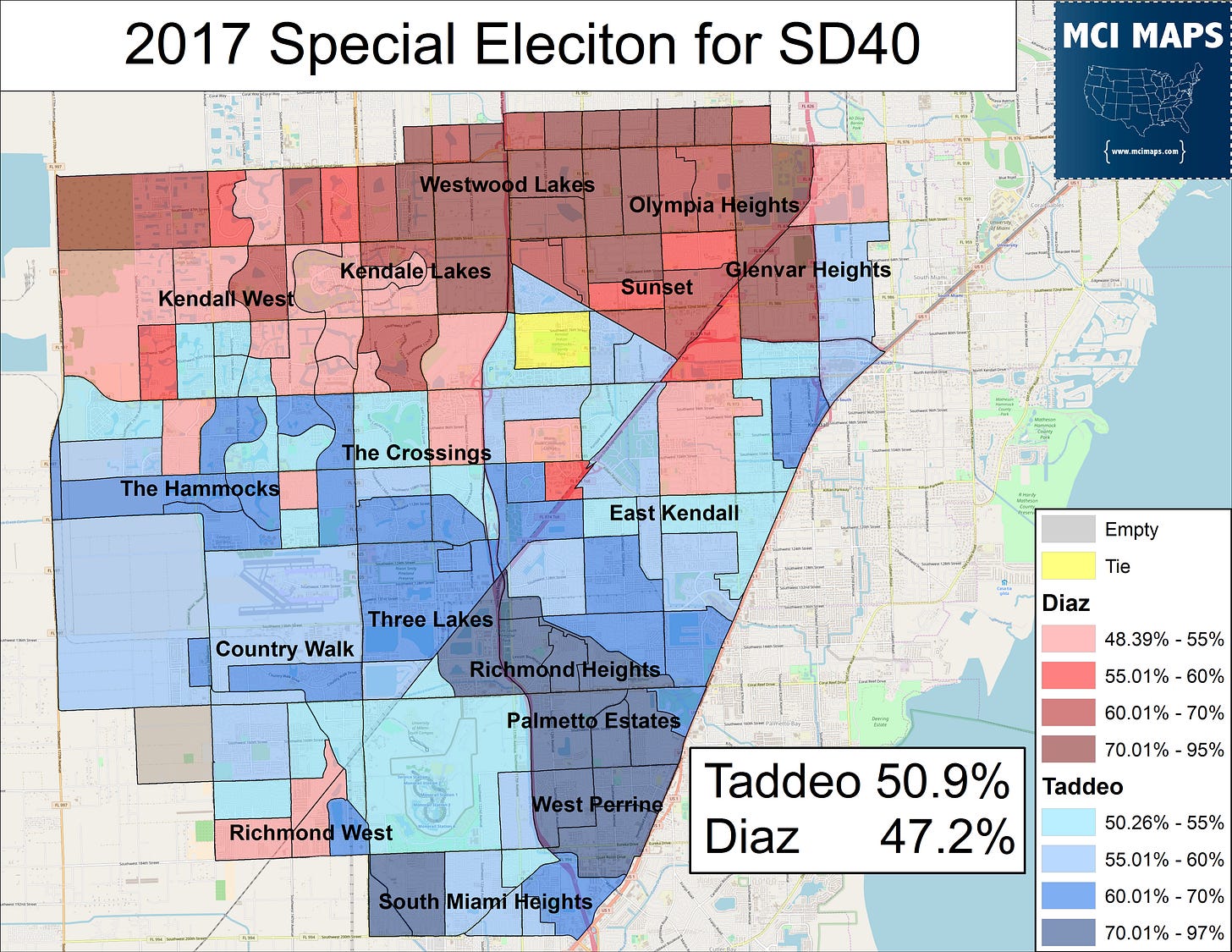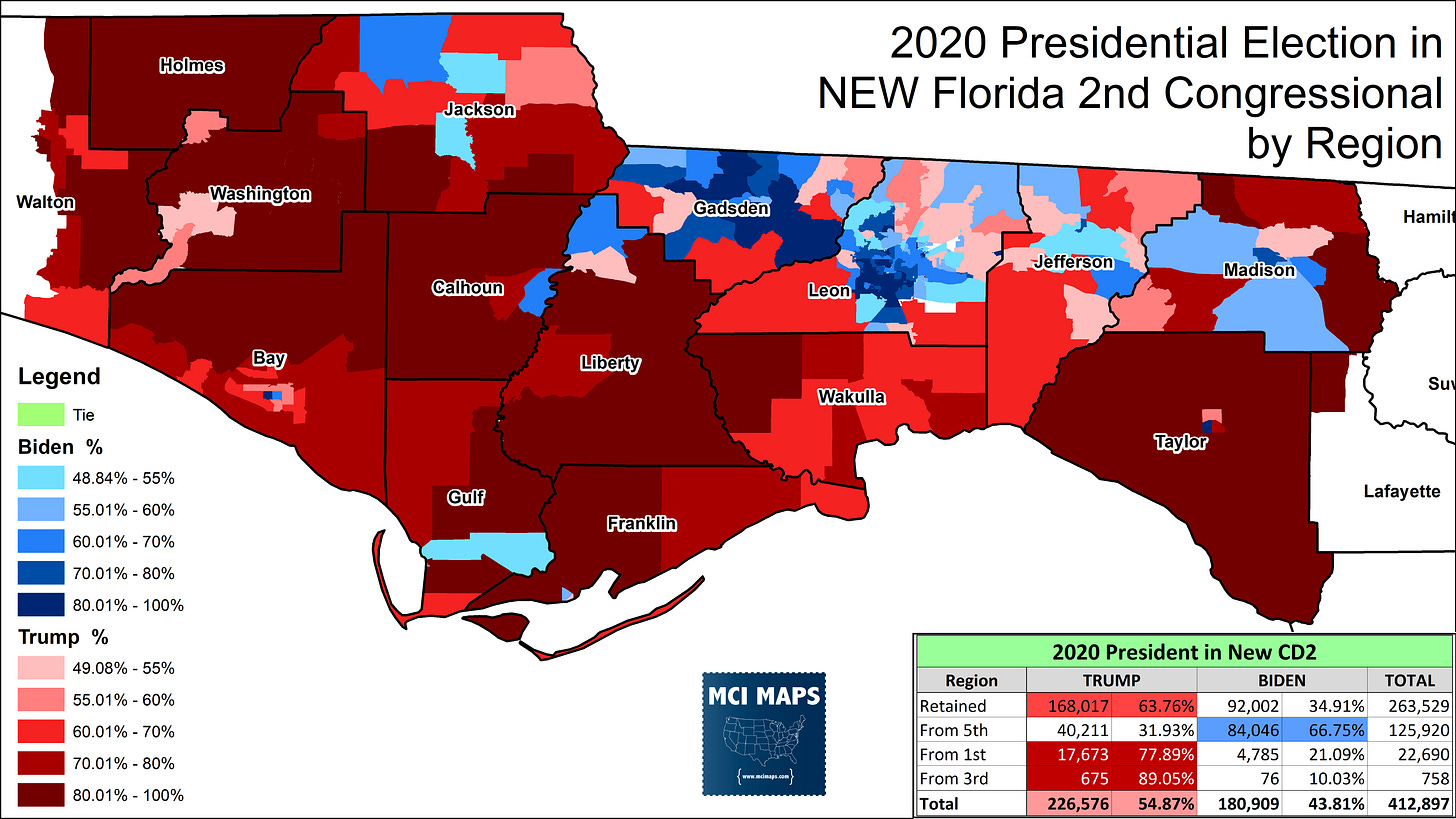Issue #54: In the Florida 2nd and 27th, Taddeo and Lawson give Democrats a boost
The seats may stay red, but at minimum Democrats have strong choices
With Florida’s qualifying deadline a week away, candidates have been making final decisions on the offices they will run for. Democrats are in a bad way with the Congressional map being so skewed to Republicans. That said, this week, two prominent Democrats made their intentions clear.
On Monday, State Senator Annette Taddeo ended her Gubernatorial campaign and announced a run for the 27th Congressional district. On Thursday, Florida 5th Congressman Al Lawson, who’d been awaiting final court decisions on the map, announced he would run against Congressman Neil Young in the 2nd Congressional district.
Lets do a quick dive into each announcement.
Taddeo and the 27th
Annette Taddeo, who represents a state senate seat in the heart of Miami-Dade, has been running for Governor since last year. Taddeo’s entry had fanfare, but she suffered from Agriculture Commissioner Nikki Fried and Congressman Charlie Crist dominating the coverage. Taddeo has routinely polled in 3rd, and recent polls show Crist above 50%, well ahead of both her and Fried. Over the last few weeks, rumors swirled about Taddeo making a change. Democrats struggled to recruit for the 27th, which narrowly voted for Trump.
The 27th, like all of Miami-Dade, took a notable shift to the right in 2020. Hillary Clinton won the district by 17 points in 2016. In 2018, which saw a sizable slide to the GOP in Miami-Dade, Nikki Fried, Bill Nelson, and Andrew Gillum all won the district by 8 to 10 points.
Whether the Miami-Dade (and Hispanic overall) shift in 2020 is a new baseline, or a tilt further to right, or back to the left, remains to be seen. Democrats, fearing a 2022 red wave, remained more inclined to wait for 2024 or later to run for these marginal seats. It also did not help that Republicans did shift the district more to the right with redistricting. The final plan carved out Democrat-heavy Miami-Beach from the district.
The district saw heavily blue communities excised from the district, while more GOP-friendly precincts were added. This converted the old 27th, which voted for Biden by 3%, to narrowly backing Trump.
Taddeo does give Democrats a strong recruit. She won her state senate seat in a very contentious special election in 2017. I covered that race here. Taddeo flipped the district for Democrats, defeating State Rep Jose Felix Diaz.
A year later, Taddeo would have to defend her seat again. She won a full term by 7%. In both races, her weakest areas were the Cuban-heavy Northern precincts. She was strongest in white, black, and non-Cuban Hispanic precincts that cover the central and southern portion of the district.
On a quick note, Taddeo’s exit from the Gubernatorial primary doesn’t change the dynamic that much. Crist appears to remain strongly in the lead. It seems more likely than not Taddeo will back Crist, as she was his running mate in 2014. That said, she could remain neutral. This does mean Miami-Dade’s Hispanic voting block is wide open for grabs. Hispanic voters make up 12% of current Democratic primaries.
We will delve further into the Democratic primary for governor down the line. In the meantime, the DCCC is happy, as they have a candidate they’ve been trying to recruit for some time. Taddeo gives Democrats a strong name for the race.
Al Lawson for the 2nd
With the hope of the 5th Congressional district being restored fading, despite a judge ruling the new map was a clear racial gerrymander - only to be halted by the appeals courts - the question emerged over what Congressman Al Lawson would do. Lawson had already floated the idea of running for the 2nd, which includes part of his 5th district and part of Neil Dunn’s current 2nd.
The new district voted for Donald Trump by 11 points. This is way down from Dunn’s current district, which backed Trump by 35 points. That said, its still decently red.
The last statewide Democrat to win the new 2nd district was Bill Nelson. In 2012, Nelson won statewide by 13 points, sweeping much of the state. Otherwise, Democrats have been unable to move past Republicans in the region.
Realistically this gives Lawson little chance to flip the seat. In my article on the electoral history of Al Lawson, you can see how the panhandle used to be dominated by down-ballot democrats. Lawson was first elected to the state house, covering Liberty, Leon, Wakulla, and Franklin counties, in 1982. Back then, no Republicans bothered to file for these seats.
In 2000, Lawson would win a state senate seat, heavily outperforming the Gore margins in the panhandle.
However, as time moved on, ticket-splitting reduced; especially for federal races. When Lawson ran for the 2nd district in 2012, he lost to Congressman Steve Southerland (who had ousted blue-dog Democrat Allen Boyd in 2010) by 5 points.
Lawson’s 5 point loss was better than Obama’s 6 point loss. However, the large improvements in places like Liberty and Franklin were not enough.
So heading into 2022, in a district Trump won by 11, it is hard to see Lawson winning the district. HOWEVER, what the Congressman is doing by running is giving his constituents a voice. Lawson has represented the African-American voters of the panhandle for six years. Those voters in the new 2nd will be able to cast the ballot for him, even though the entire 5th district was cracked across FOUR seats.


Lawson’s presence on the ballot will also be a big boon to Democrats running in the region. Democrats will face Republicans in State Senate 3 and State House 9, which all have overlap with Lawson’s old 5th, and will benefit from every African-American voter that Lawson can bring to the ballot box. Even if Lawson loses, he helps regional democrats.
Both candidates give Democrats a reason to be happy. Flipping the 27th won’t be easy, and flipping the 2nd will be much harder. However, strong candidates is always good for turnout; which can effect statewide and regional races. Democrats can be happy that they have strong candidates in these districts.















